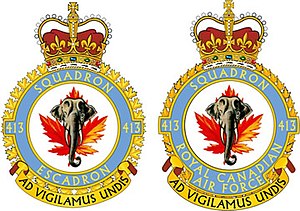413 Transport and Rescue Squadron
| 413 Transport and Rescue Squadron | |
|---|---|

Squadron badge
|
|
| Active | 1941-1945 1947-1950 1951-1961 1968- present |
| Country | Canada |
| Branch | Royal Canadian Air Force |
| Role | Transport and rescue |
| Part of | 14 Wing Greenwood |
| Home station | CFB Greenwood |
| Nickname(s) | Tusker |
| Motto(s) |
Ad vigilamus undis ("We watch the waves") |
| Battle honours |
|
| Insignia | |
| Squadron Badge | Elephant head over a maple leaf |
| Aircraft flown | |
| Fighter | F-86 Sabre, Avro CF-100 |
| Patrol | PBY Catalina |
| Transport |
C-130 Hercules CH-149 Cormorant |
413 Transport and Rescue Squadron is an air force squadron of the Canadian Armed Forces. It was originally a flying boat squadron of the Royal Canadian Air Force during the Second World War. It currently operates the C-130 Hercules and the CH-149 Cormorant in transport plus search and rescue roles at CFB Greenwood.
413 Squadron was created as the third RCAF squadron attached to the RAF Coastal Command and equipped with PBY Catalina flying boats. The squadron gained fame for the actions of Squadron Leader Leonard Birchall, who detected a large Japanese task force approaching Ceylon. This allowed time for the defenders to prepare, and foiled what could have been a major blow to the Royal Navy in the Indian Ocean. The squadron was disbanded in February 1945.
Reformed at RCAF Rockcliffe on April 1, 1947, it took over the duties of No. 13 (Photographic) Squadron. It operated in this role until November 1, 1950.
The squadron reformed again on August 1, 1951 as a fighter squadron at CFB Bagotville. Equipped with the F-86 Sabre they deployed to Zweibrücken, Germany. The squadron stood down on April 7, 1957 and was then reformed on May 1 operating the Avro CF-100 Canuck at Bagotville. The squadron again disbanded on December 30, 1961.
The squadron was reactivated at CFB Summerside on July 8, 1968 in its current role of a Transportation and Rescue Squadron. With the closure of Summerside, the squadron relocated to CFB Greenwood on June 10, 1991.
...
Wikipedia
